
Today more retailers are seeking unified commerce—or a seamless customer experience irrespective of channel. According to Zendesk, “87% of customers think brands need to put more effort into providing a seamless experience.”
And the benefits for retailers are significant. In fact, a study done by Google found that omnichannel shoppers have a 30% higher lifetime value than those who shop using only one channel.
While brands refer to this as a “unified commerce” approach— the foundation of being able to achieve unity throughout your supply chain is built on an omnichannel retail mindset.
What is unified commerce? How does an omnichannel strategy impact brand experience? In this article we'll walk through how brands are building a cohesive unified commerce strategy.
Table of Contents
- A Brief History of Retail Channels
- Enter Omnichannel Retail
- Benefits of an Omnichannel Approach
- How to build an Omnichannel Retail Strategy
- How Technology Empowers Omnichannel
- Examples of Omnichannel Retail
A Brief History of Retail Channels
Before we dig into exactly what omnichannel retail is, let’s set the context for how shopping channels have evolved over time.
In the fall of 2018, the once dominating retail giant, Sears, filed for Chapter 11 bankruptcy. As news of the big-box downfall spread, people began to reminisce about the days of catalog shopping.
To many modern consumers, the idea of browsing a catalog, filling out a paper form, and mailing a check for payment seems almost unbelievably antiquated. Yet Sears successfully sold everything from clothes, jewelry, firearms, livestock, to even mail-order “kit homes” you could build yourself.

But as competition grew, and Sears stayed the course with the same retail model, the beloved brand, in the words of the Wall Street Journal headline, “lost the American shopper.”
Sears is a case-study-worthy tale of a brand not adapting to a changing retail landscape—and assuming that what has always worked will continue to yield the same results. However, retailers now know that the world of commerce is incredibly dynamic, and there is a sense of Darwinism’s survival of the fittest for those that won’t (or can’t) adapt.
Retail began mostly as a single channel model, where consumers expected to visit a brick-and-mortar store to purchase. Eventually, new channels began to emerge.
-
- 1845 - Mail-ordering originates with the Tiffany catalog
- 1893 – Sears, Roebuck, & Co. releases their first mail-order catalog
- 1982 – The first TV shopping network launches, Home Shopping
- 1991 – The first electronic commerce store launched, Book Stacks Unlimited
- 1994 - Money magazine published a story about the sharp rise in people "shopping from home"
- 1995 – Jeff Bezos launches Amazon.com as an online marketplace for books
- 1997 - Mobile commerce, also known as m-commerce begins via SMS texting
- 2007 - Smart-phone mobile commerce introduced
- 2010 – Omnichannel thinking introduced to the retail landscape
For example, a retailer would have “store” inventory separate from ecommerce inventory, making it complicated and cumbersome if a consumer purchased something from one channel but need to return/exchange in a different channel. Retail associates wouldn’t necessarily know how to “pick, pack, and ship” an item to consumers.
While multichannel gave consumers more options for shopping, it often led to complex retail operations, disparate systems, and complicated reporting.
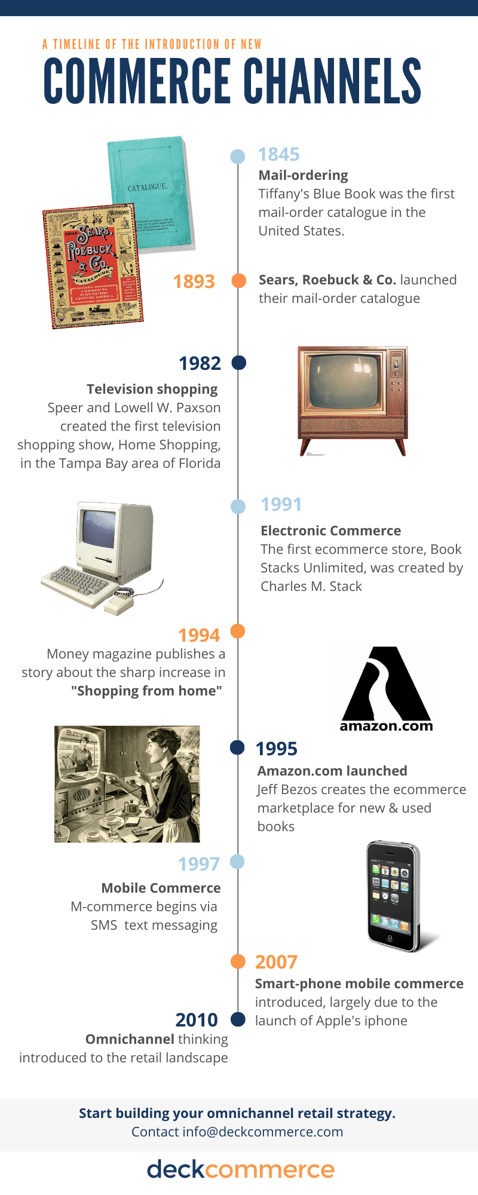
Enter Omnichannel Retail
In 2010, retailers began to look for an approach that extended beyond multichannel.
Omnichannel retail (omni meaning “all”) links every retail channel together to build a seamless customer journey. Research shows that consumers are interacting with brands on a variety of channels and becoming more and more “channel agnostic.”
Simply put—consumers are looking for a unified brand experience, whether they are browsing a brick-and-mortar store, shopping on their smart phone, or buying online and picking up in the store.
The statistics for “omni-shoppers" show that they tend to spend more (both transaction size and lifetime value) and have a higher customer retention rate. So as retailers aim to target new customers, get them to engage with their brand, and keep them coming back for more—an omnichannel approach has proven an effective way to do so.
Benefits of an Omnichannel Approach
While sales and revenue can drive omnichannel strategies, there are many more benefits to a unified commerce experience:
- A customer-first approach by engaging buyers exactly where, when, and how they want to buy. They can start a purchase on one channel and complete it on another.
- More robust supply chain and fulfillment capabilities such as leveraging stores as fulfillment centers (in-store fulfillment), buy online pick up in store (BOPIS), buy online return in store (BORIS), curbside pickup, same-day fulfillment, ship to store, and gift cards, etc.
- More protection against lost sales to competitors due to poor inventory management (i.e. out-of-stock products or disparate inventory across your distribution network).
- Increased ability to scale your business for growth by providing a strong foundation for operational processes and your technology stack.
- Sell more products by exposing and leveraging more available to sell inventory—regardless of where it's located.
- Retail channel agility as the landscape morphs and changes (i.e. customer expectations, COVID-19, digital transformation, etc.)
- Increased visibility into your retail brand’s overall performance versus only siloed views per channel
How to Build an Omnichannel Retail Strategy
- Assess — Understand your current customer journey “as is.” How do your consumers like to buy? What is their path to purchase? What data and trends do you see that impact their preferences and patterns? What does a winning retail strategy look like for your brand?
- Outline priorities — What are critical must-haves for your omnichannel strategy? Why are they critical to your fulfillment plan? What departments, teams and overall functions will this impact and involve?
- Identify processes and systems throughout your supply chain that may require an omnichannel reboot:
- Product catalog – How many SKUs do you have? Do you sell kits or bundles that impact fulfillment? Do you offer personalized products that require review before manufacturing?
- Overall distribution network capabilities – How many customers can you reach, and how quickly?
- Technology touch points – How are your point of sale, ecommerce storefronts, ERPs impacted? What system, if any, gives you the overall view of sales/orders? What integrations do you need?
- Inventory – Where is it stored? Is it the same across channels? Where can you fulfill orders? Is there a view of store-level inventory? Are inventory feeds consolidated, aggregated and allocated appropriately in real-time? Do you offer preorders and backorders that impact your inventory count?
-
Order Routing & Orchestration - What unique workflows or routing requirements does your brand require? Do you have a tool that offers advanced logic routing based on business best practices like ship complete, split shipment, or proximity? What about unique workflows for dropshipping and retailer requirements?
- Finance – Think about how to handle payment capture, tax, fraud, gift cards, etc.
- Return management authorization (RMA) – Who initiates? Where can buyers return products? How can you streamline your returns? What are return and exchange management best practices?
- Standardize — Unify your customer experience across all channels including return policies, promotions, etc. to prevent confusing or frustrating buyers.
- Leverage an order management system (OMS) like Deck Commerce OMS to automate order workflows and take advantage of various fulfillment options
- Order orchestration capabilities - Enable real-time aggregation and fulfillment routing. (Learn more)
- Enterprise-level inventory across every channel including available to sell and safety stock (Learn more)
- Robust transaction processing – Include advanced/delay capture, order reviews, etc. (Learn more)
- Omnichannel Fulfillment - Enable buy, fulfill, and return anywhere. (Learn more)
- Advanced customer service - Give your service associates a 360 view of your customers. (Learn more)
- Aggregate view of all orders for exception management, return automation, appeasement, etc.
- Empower brand associates — Give in-store workers and online/over-the-phone customer service representative full visibility to data and orders information in real-time
- Partner with “omni-minded” partners, vendors, and systems — Find those who understand your business needs and are adapting to unified commerce requirements
- Test your order lifecycle from beginning to end – Ensure both business requirements and customer experience meet expectations for all channel combinations [(in-store fulfillment), buy online pick up in store (BOPIS), buy online return in store (BORIS), same-day fulfillment, ship to store, and gift cards, etc.]
- Measure performance and KPIs — With an omnichannel strategy, you will have visibility into the picture of your retail brand as a whole.
How Technology Empowers Omnichannel
The technology stack (or set of technology tools) behind your brand either prohibits or enables you from executing the customer experience you aim to create. For many retail brands, the "secret sauce" to creating an omnichannel customer experience is through leveraging an order management system (OMS).
Not sure if OMS is the right option for you? Here are 3 Signs Retailers Need an OMS.
.png?width=1200&name=3%20LinkedIn%20Template%20(3).png)
An order management system effectively covers the entire lifecycle of your orders—from click to doorstep—and gives your brand fulfillment capabilities and visibility you don't have without OMS. But not all order management solutions are created equal. Understand your options for order management systems and their short and long-term benefits.
Examples of Omnichannel Retail
Ship from store
Build-A-Bear is known for its unique in-store experiences where children can create their own furry friends to take home. With the increase in online shopping, Build-A-Bear mirrored that unique in-store experience on their website. They give customers the option to include online-recorded voice messages with their gift—allowing family members to send special messages even while they are apart.
To keep up with the influx of online orders, Build-A-Bear turned their retail spaces into micro distribution centers (in just four weeks) through their use of their order management system. Not only did this keep stores operational during the pandemic, but now, Build-A-Bear has an infrastructure in place for a broader distribution network and the ability to offer a true omnichannel customer experience.
Curbside Pickup
A recent study found that 33% of millennials who developed the habit of using curbside pickup during the pandemic plan to continue to do so. The immediacy of fulfillment that curbside pickup provides appeals to many shoppers—especially when some brands like Dick's Sporting Goods, have orders ready in as little as one hour. By showcasing local store inventory on their storefront, retailers can provide their customers with an additional convenient way to pick up their orders.
Marketplace Selling
Omnichannel retail doesn't solely mean fulfillment options. It also includes how consumers expect the same experience with a brand even on different selling channels. Take for example, Native Shoes. Their customer experience needs to extend to any location where their shoes are being sold whether it's Amazon, Zappos, Walmart, etc.
One way they can ensure that experience is being upheld is by having full visibility into all of their inventory in all of their different selling channels. This allows them to allocate inventory where needed to not lose out on any potential sale due to "out of stock" messaging.
Summary
Whether you are a seasoned omnichannel connoisseur, or just now assessing how to adapt your retail strategy into a true unified experience—one thing is clear— customers are in the driver’s seat and they are on the omnichannel highway.
But heading towards a unified brand experience doesn’t mean you have to abandon your historic brand identity. Who knows what Sears could have become if they were open to adapting their business model to meet consumer preferences? Perhaps they would still be competing with other retail giants that have stood the test of time?
The CEO of Levi’s, Charles Bergh, points out that brands should “…have one foot rooted at the heritage of the past to make sure we understand where we came from, and one confident step forward in terms of driving innovation forward.”
A unified commerce experience is not only a step forward — it is a step towards where the customers already are.

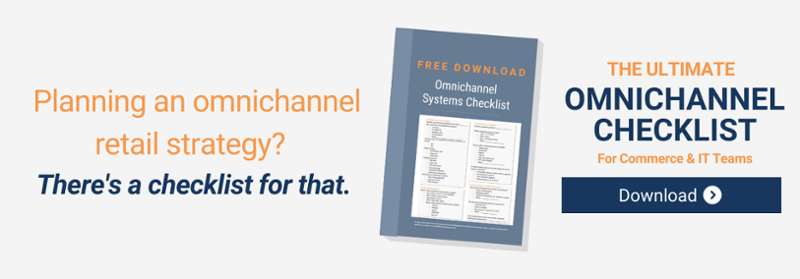





.png?width=2000&height=2000&name=Blog%20Directory%20CTA%202000x2000%20px%20(2).png)
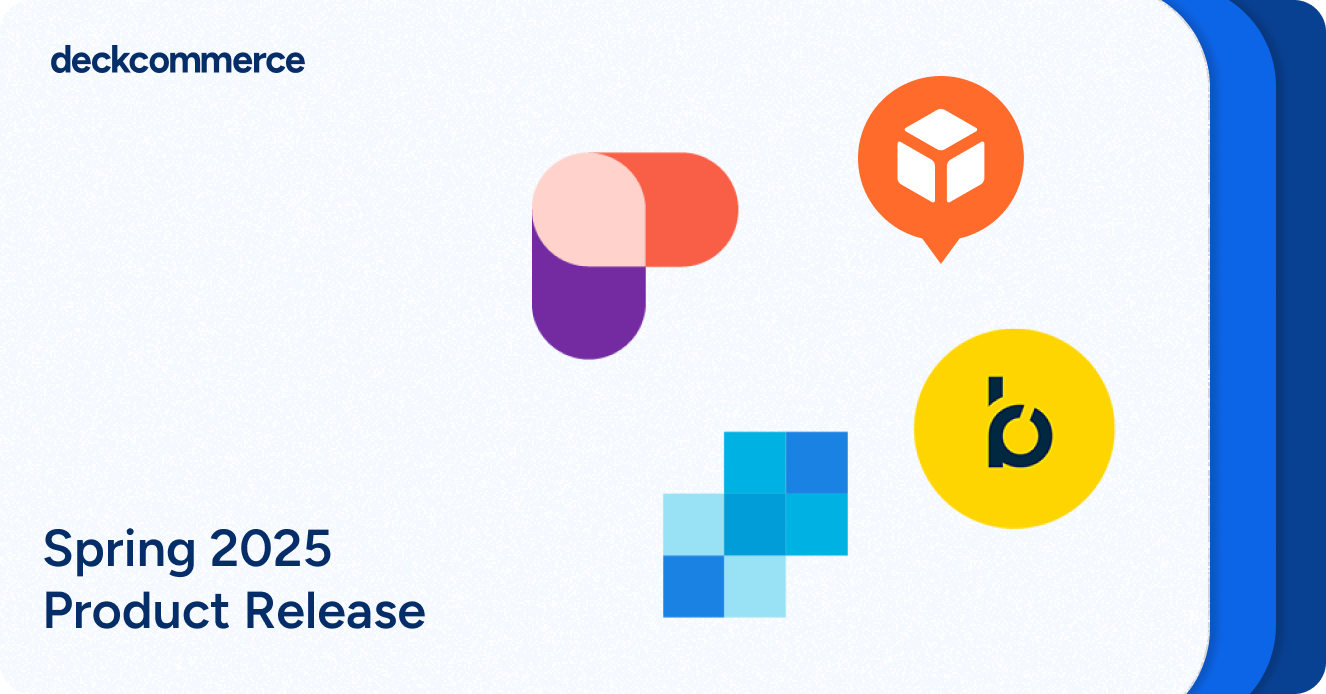


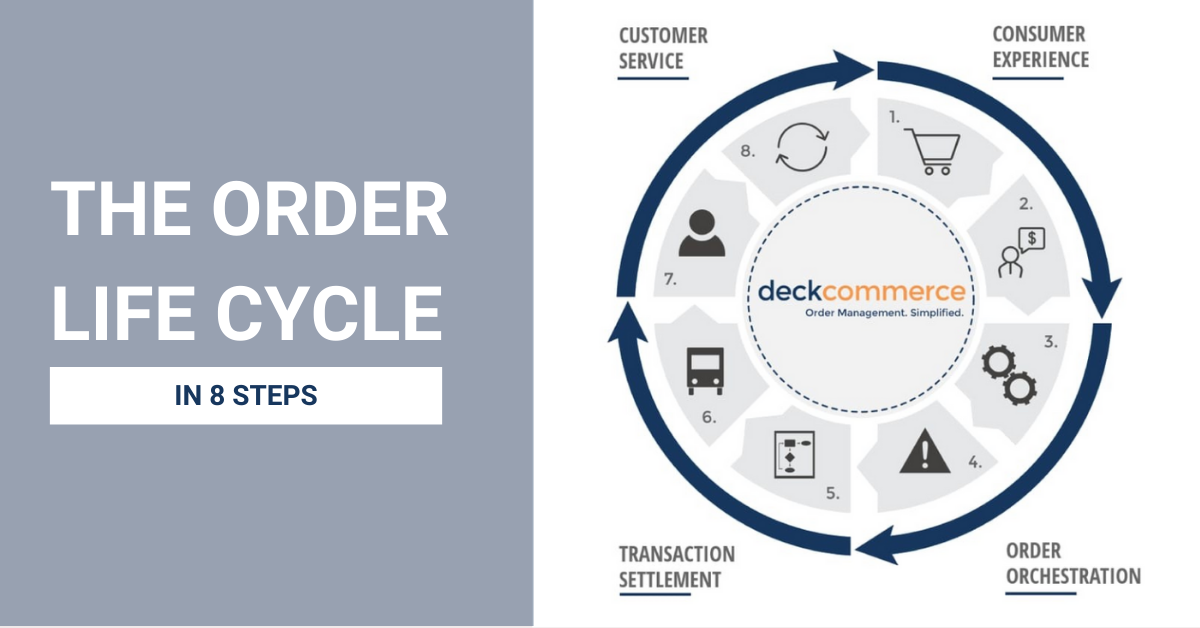
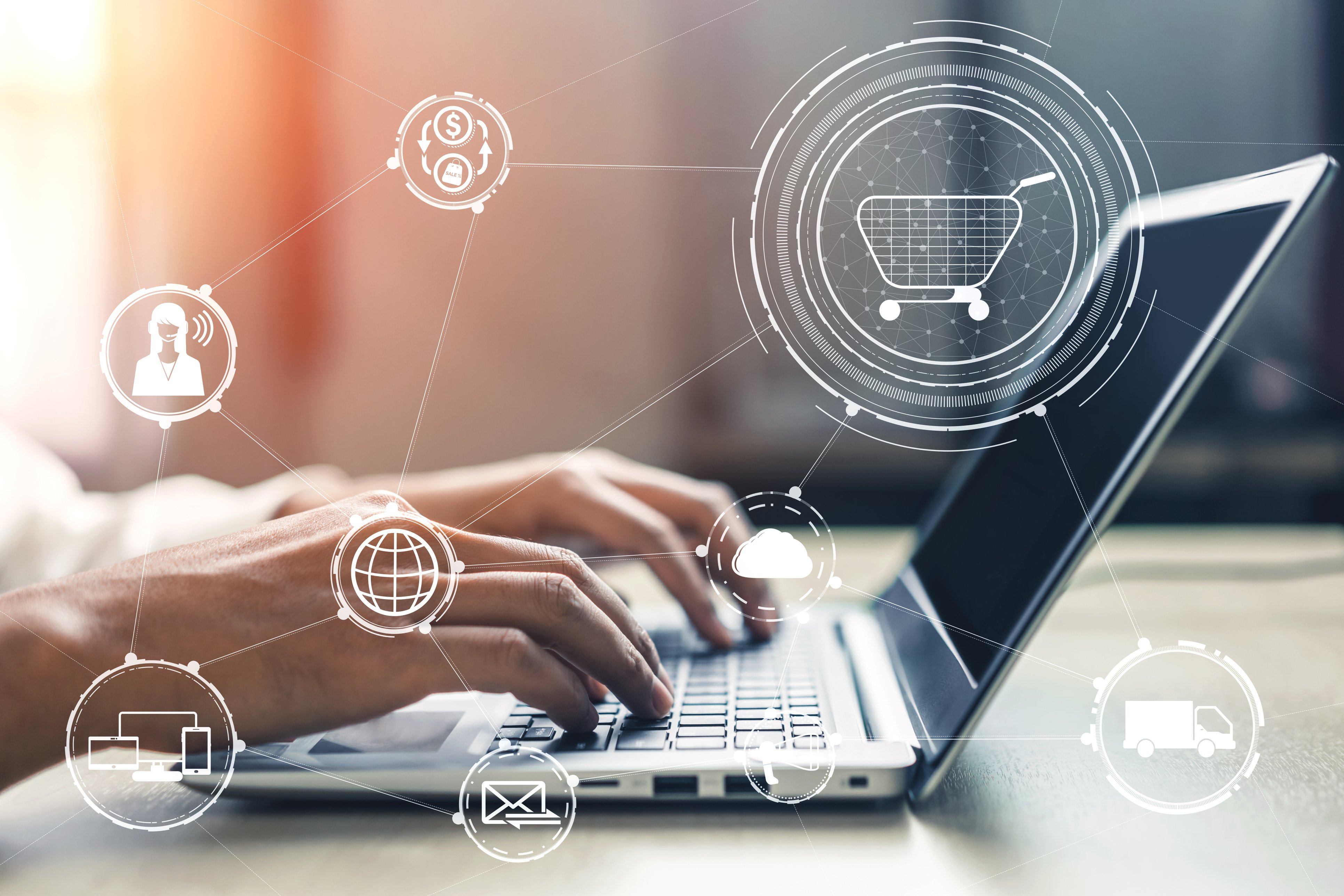
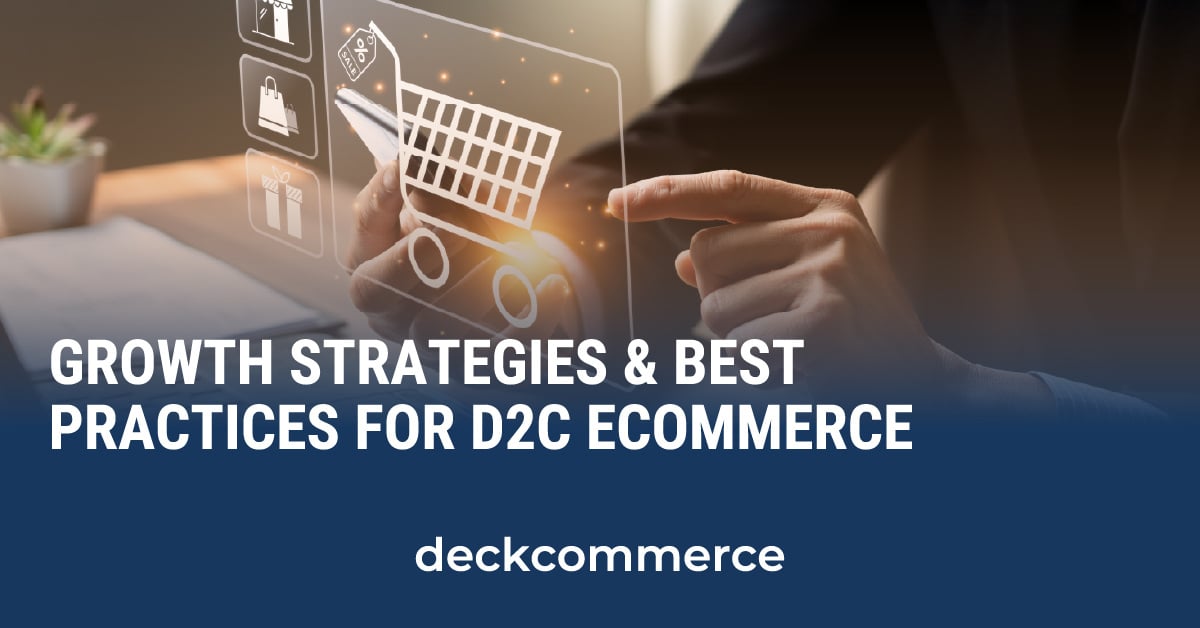
.png?width=2000&height=2000&name=Blog%20Directory%20CTA%202000x2000%20px%20(3).png)
